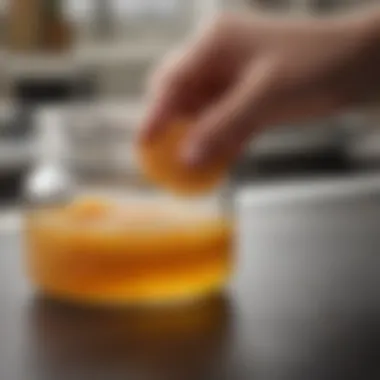Effective Strategies for Opening Tight Jars Easily


Intro
Opening a tight jar can often feel like a formidable task, leading to frustration and the desire to resort to drastic measures. The struggle is common; many find themselves wrestling with stubborn lids that seem glued on. This article aims to demystify the process of opening jars, offering various techniques and tools that can simplify the task.
Instead of forcing the lid and risking injury, we explore practical methods that protect your hands while efficiently loosening jar tops. Understanding the underlying factors influencing lid tightness can also aid in making intelligent choices when storing jars and selecting products. Let's delve into the essential strategies that promise to enhance your kitchen experience.
Techniques for Loosening Jar Lids
Opening a jar does not have to be a Herculean feat. Here are several effective strategies each designed to minimize effort while maximizing success:
Grip Enhancements
- Rubber Jar Openers: These tools provide additional protection to your hands and effectively grip screws. They come in various shapes and designs, tailored for a range of lid sizes.
- Dishcloths: A simple dishcloth can transform a slippery surface. Wrap it around the lid to improve grip and provide leverage.
- Gloves: If moisture is an issue, consider rubber gloves for better traction.
Applying Heat or Cold
Temperature shifts can breech the otherwise firm bond holding the lid. Take these actions:
- Warm Water Soak: Submerge the jar lid in warm water for roughly one minute, allowing thermodynamics to work on the seal. This can expand the metal, creating slight variance and enabling easier opening.
- Ice Pack Application: Conversely, if the jar is plastic, applying an ice pack around the jar might help. The expansion from the heat haws gone will help loosening stuck lids.
Innovative Tools
If manual methods fail, consider employing specialized gadgets:
- Jar openers with adjustable grips can adapt to any size.
- Electric jar openers may serve as the ultimate solution, especially for those who have difficulty with manual options.
Key Point: Always inspect the jar and seal for damage before applying methods. Cracks can lead to shattering.
Understanding Jar Seals and Factors Involved
Jar tightness could owe to various factors that sometimes go unnoticed. Understanding these factors reduces the chances of unnecessary difficulty in the kitchen.
Pressure and Bag Types
Jars sealed under pressure retain freshness. Additionally, those made of glass or plastic influence how well they can resist force when opened. Always remember: tightly closed lids may retain a vacuum, making them more challenging to lift.
Settling Time
Some products might require a period to settle before an attempt to open. Ingredients such as pickles or preserves may tighten after bottling—a reality faced by many food lovers; patience here is valuable. Having rim space facilitated by proper solution placement can prevent future challenges.
Reflections on Jar Opening Experiences
Effective techniques for opening varying types of jars can lead to satisfaction and an empowering kitchen dynamic. Embracing these methods will reduce undue stress. In the following sections, we explore additional arrangements to smooth this essential kitchen experience.
Understanding Jar Seals
Understanding the seals of jars is crucial for any cooking enthusiast. This section delves into the mechanics behind why jars sometimes refuse to budge. Knowledge about these seals offers benefits like preventing frustration during use and extending the life expectancy of food contents.


The Mechanics of Jar Sealing
How vacuum sealing works
Vacuum sealing is a method that removes air from the jar, creating a tight seal. This process keeps food fresh for a longer duration by minimizing oxidation. A key characteristic of this method is its ability to preserve flavor and texture.
However, vacuum seals can also lead to jars being harder to open. Once sealed, the pressure inside the jar increases, which can make it challenging to twist off the lid. A benefit of vacuum sealing is how it protects food from contaminants, yet it can backfire if individuals do not apply the right technique when trying to open.
The role of pressure in jar openings
Pressure plays a major role in how jars are opened. When you twist the cover, you are working against both the internal vacuum pressure as well as atmospheric pressure. If the pressure inside the jar is noticeably high, it requires greater force to lift the lid. A notable characteristic here is how shifting the pressure can make it easier to open the jar effectively.
This is beneficial during the jar opening process because understanding it relates directly to developing effective techniques. Unique to this pressure scenario, navigating the balance is vital. If excessive force is applied, it could result in cracking the glass, thus presenting a disadvantage.
Common Causes of Stuck Jars
Temperature and its effect on sealing
Temperature significantly impacts the way jars seal. Hot temperatures generally expand materials, making sealing once completed more secure. The high heat from processing may make materials stretch. When cooling processes finish, shrinkage and contraction can add to this tight seal.
This means that if jars sit in a warmer environment for too long, they can become difficult to open later. Understanding this can be beneficial as it helps to prepare and adapt strategies for future convenience. A notable feature is how temperature changes lead to expanding or contracting the jar’s content, contributing directly to stubborn lids.
Humidity and material interaction
Humidity is another crucial factor affecting jar seals. High humidity conditions may cause jar lids to rust. This dampness affects not only the lid but also the jars themselves. When moisture mixes with the seal's material, it can bond tightly, making the jar harder to remove.
Witnessing changes in food contents can spark interest in learning more about food storage practices, as recognizing the unique features of humidity levels is essential. This knowledge might come handy even before dealing with potentially stuck jars, helping to establish resilient sealing conditions in future situations.
Understanding both temperature and humidity can impact performance when attempting to open jars.
Techniques for Opening Tight Jars
Opening tight jars can be frustrating. Mastering effective techniques not only enhances kitchen proficiency, but can also help prevent unnecessary strain. Understanding and employing various methods ensures that one can open jars safely and efficiently.
Manual Methods
Using friction to enhance grip
Using friction can significantly improve grasp around jar lids. Friction occurs when surfaces rub together, providing a more durable hold. This approach is popular due to its simplicity and minor resource requirements, as almost everyone has cloths or textured materials at hand. A key advantage is its extensive availability—using a rubber glove or even a piece of textured fabric can make the process easier. However, it may not be extremely effective for very slippery lids or for those dealing with hand strength limitations, potentially causing discomfort rather than solving the problem.
Applying rotation techniques
Rotation methods capitalize on the ability to turn the lid in a systematic way. This tactic requires only a rotation of the wrist wrist, rather than excessive force. It is often a favoured choice because of its practical nature—just grip and twist using the correct motions. A unique characteristic of this method is how it takes advantage of leverage, making it easier to systematically identify the sweet spot for loosening the seal. Despite its effectiveness, rotation techniques assume a level of strength and coordination, which may restrict some individuals.
Leverage Techniques
Employing a rubber band for grip


A rubber band is an effective item for enhancing grip on jars. The use of such materials increase the contact area around the lid. This makes grasping much easier. The elasticity of the band offers the additional benefit of adjusting to various lid sizes. This technique is popular among individuals that prefer low-tech, easy solutions for everyday problems. However, it might not work well on lids too slick or when in humid conditions, diminishing the band’s effectiveness.
Using a spoon or other tool as a lever
Tools such as a spoon can serve as formidable leverage alternatives. By inserting a spoon between the lid and the jar itself, one could create an upward force to break the seal. This quality of transforming regular utensils into functional helpers aligns well for those who prefer multi-use strategies. By leveraging a spoon, potential injuries related to direct force applications on hands can be avoided. On the flip side, improper use could lead to damaging the jar or hurting oneself, necessitating a nuanced approach when applying this method.
Using simple, effective techniques is crucial to avoid strenuous efforts and potential injuries.
Utilizing these methods should make the task more manageable. Adapting these techniques intelligently allows better versatility for various scenarios at home.
Tools and Gadgets for Jar Opening
Opening tight jars smoothly can often feel like a monumental task. Fortunately, there are a variety of tools and gadgets designed specifically to ease this process. Their adaptability and specialized functionality can save time, effort, and even prevent frustrating injuries that can occur when forcefully twisting open stubborn lids. Knowing the right tool can ultimately make the difference between a kitchen victory and a disappointing failure.
Exploring Jar Openers
Differentiating manual versus electric options
When selecting a jar opener, it is crucial to understand the contrast between the manual and electric variants. Manual jar openers have been popular among home cooks for years. They typically employ leverage or additional grip. Meanwhile, electric openers present a more accessible solution. They can handle stress with a simple push of a button.
Key characteristics to note are their ease of use. Manual openers usually rely on fundamental mechanics, while electric alternatives offer convenience through battery power. The major benefit of electric models is that they dismiss excessive twisting, making them an ideal choice for individuals with health concerns like arthritis. Yet, the downside lies in dependency on battery life and potential malfunction.
Selecting the right jar opener for specific jars
Choosing the correct jar opener hinges on understanding the type of jars one tends to encounter. Different shapes and sizes require distinct tools for effective opening. For instance, wide-mouth jars may be better served by particular designs with a more rounded or accommodating grabbing surface. On the other hand, smaller jars might not need overwhelming gadgets.
The most valuable characteristic of selecting a suitable opener is the attention to jar size. A well-fit opener makes the task much easier and whiler reducing risks associated with slipping. However, discussing the cons, specialized openers may take additional drawer space and may offer limitations in handling versatility.
Kitchen Tools to Consider
Using a dish towel effectively
A simple dish towel can transform itself into a practical solution for opening tight jars. By providing added grip, it prevents your hand from slipping off the lid surface while also determining a better angle for turning it effectively. This method stands as one of the most favorable techniques among experienced cooks.
The dish towel is extremely versatile, suitable for various jar sizes and types, thus enriching its suitability for many. Leveraging the fabric’s texture enhances the force that can be applied without risk of injury. Conversely, limitations are minimal, aside from potential cleanliness concerns if the towel is not maintained properly.
Employing heat-induced methods
Exposing jar lids to slight heat can generate an expansion effect that alleviates tight seals significantly. Warm water or using tools like a heat gun creates this desired effect. Consequently, the expanded lid may twist open with ease.
Employing heat stimuli offers a recognizable advantage over constant physical strain. The approach capitalizes on principles of materials science and demonstrates effective problem-solving. Nonetheless, users must practice care, ensuring the methods used do not escalate into burns or overheating concerns for the glass jar. This calls for caution whenever one resort to these methods.
The right tools and gadgets can transform how effortlessly one can open jars, ensuring safety and efficiency are prioritized in the process.
Safety Considerations
When it comes to opening tight jars, safety is paramount. The last thing anyone wants is to end up with an injury or damaged items. Especially in the kitchen, both hands and tools must be used appropriately to avoid mishaps. Understanding safety considerations makes the kitchen an enjoyable space rather than a risky zone. By focusing on this area, one can enjoy cooking without constant concern about injuries.


Avoiding Injury
Understanding hand strain and force application
Proper awareness of hand strain is crucial during jar opening. Many people use excessive grip strength in attempts to uncork a tight seal. This can lead to fatigue and, in some cases, repetitive strain injuries. A balanced grip is more effective. It allows the user to use their strength efficiently without risking damage to their hands.
An important factor to note is that force heats to functiont. The ideal pressure applied on the lid should not be aggressive. Heavy force impedes control. This calls into question methods mentained for jar openings. Try lighter force compounded with technique rather than torque. However, a manageable approach keeps this method firmly within popular use.
Proper tool use to prevent accidents
Utilizing tools correctly is absolutely essential. That includes choosing the right gear. Jar openers like rubber grips and levers provide certain advantages. Using them alleviates stree on hands. It's a smart choice to reach for the right tool rather than using hands solely. For instance, tools with ergonomic designs aid in reduced strain.
Using tools improperly, however, can pose risks. It’s critical to read instructions and utilize them only for specific locations. A common mistake is using makeshift tools. Road this only leads to failure and potential inaccuracies.
Preventing Glass Breakage
Recognizing structural weaknesses in jars
Some jars have permanent or temporary weaknesses that one should be aware of. Careful observattion during opening adventures is required. A crack in glass could spell disaster. At first glance, you might miss fissures or visible damage. Be vigilant and watchful during each attempt to open and analyze carefully.
Ranking jars based incorporation design and weight helps assess how best jars fortify contents. Readying touch points benefits boast gaff from time on counter. The act of prevention ensures a less disaster-prone action within the kitchen.
Signs that indicate excessive force usage
Understanding signs of excessive force can save fairy thick skin on one's fingers. Common indications include deep pain in fingers and sharp sounds that signal distress. When tools bend or show stress marks, it means enough is enough. Another strong sign becomes visible pressure marks from the jar or tool against hand.
Noticing such details early enables one to reassess tactics. Moving into caution improves opening attempts so that enjoyment again can flow within meal prep. Recognizing limitations is overlooked but shows beneficial for avoidable injuries and future jar challenges.
Effective jar opening is not only about muscle but compliant expectations combined with attention. In the culinary journey, flexibility offers remarkable benefits.
Tips for Sustained Jar Usability
Ensuring the long-term usability of jars is essential for any kitchen enthusiast. Applying appropriate techniques helps avoid common frustrations when opening jars in the future. A few basic guidelines can lead to smoother experiences with jars, greatly benefiting the overall process considered in this article. The aim is not only to resolve the immediate challenge of opening a tight jar, but also to prevent such situations from proliferating. Simple upkeep can prolong the life of the jar's usable condition.
Maintaining Jar Seals
Keeping jar threads clean
Keeping jar threads clean emphasizes the importance of hygiene and longevity. When residues accumulate around the threads, they can affect the lid's ability to seal properly. Clean threads lead to reliable seals, which help jar contents remain fresh for longer. Another aspect is that clean conditions help prevent bacteria from forming in kitchens. Combining ease of maintenance with health benefits makes this a valuable approach.
Understanding storage conditions
Understanding storage conditions plays a crucial role in initiating optimal long-term usability. Ambient temperature and humidity can influence the integrity of jar seals. Keeping jars in a cool, dry place is generally advisable. A unique aspect of wise storage is its significant impact on both pasteurization and preservation. Monitor conditions inside a pantry or cabinet at intervals. Ensuring airtight seals ultimately eliminates the chance of unwanted air entering jars.
Best Practices for Opening
Proper storage methods post-opening
Implementing proper storage methods post-opening is paramount for maintaining food quality. Once a jar is opened, correct resealing techniques should be employed. Using the original lid undamaged indicates a faithful seal approach. Another important characteristic involves utilizing refrigeration as a way to extend shelf life. This consideration fundamentally safeguards the jercommned freshness and continues longevity anticipated in contents.
Preventive measures for future use
Preventive measures for future use help mitigate possible troubles before they begin. A primary aspect includes proactively checking for faulty seals within unopened jars. Dividing jars into specific categories is a practical goal. With thoughtful organization, unwanted situations of tightly sealed jars become less likely. Using appropriate tools can also prevent many challenges one may encounter down the road.
Final thought: Applying a combination of clean storage practices along with cautious opening techniques leads to an efficient, pain-free jar experience in the kitchen.







